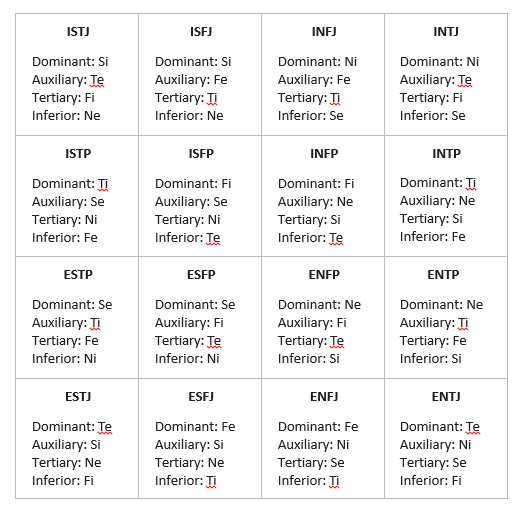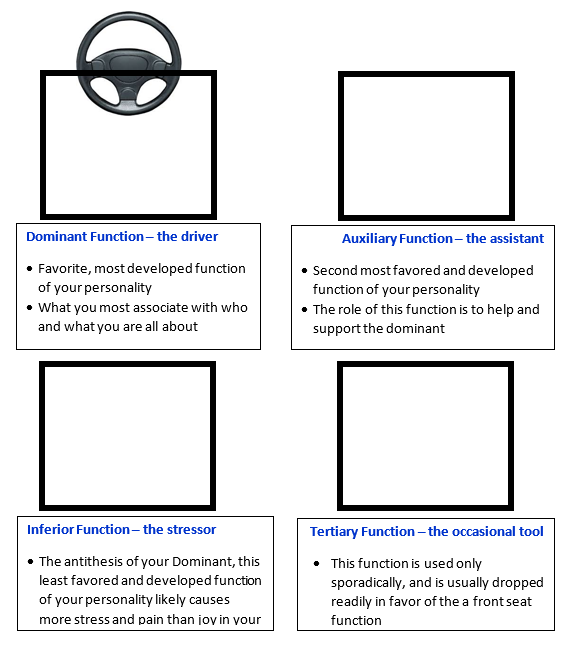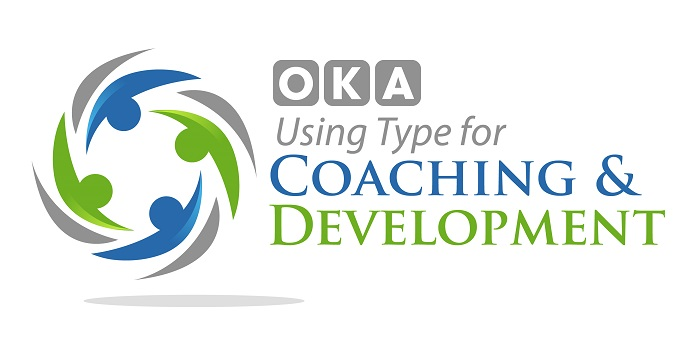Type’s Building Blocks
At the heart of Jung’s theory of Psychological Type are the four mental functions and the assertion that we are constantly toggling back and forth between these four essential mental processes: Sensing, iNtuition, Thinking, and Feeling. Jung’s full theory implies more complexity and richness, however, by suggesting that each function has an extraverted and introverted expression, which changes not only the experience, but the look and sound of each function. These simple facts mean that all of Type’s richness and power come from the following 8 mental functions—the building blocks of Type.
 Sensing is the perceiving function that takes in data through the five senses, but there is a difference between extraverted and introverted Sensing:
Sensing is the perceiving function that takes in data through the five senses, but there is a difference between extraverted and introverted Sensing:
Si: Introverted Sensing
- Internal archive of past experience and data
- Data-rich, historical, and past-focused source of data—things already seen, heard, touched, smelled, tasted, and experienced
- Archiving and recalling facts and specifics in detail and sequence
Se: Extraverted Sensing
- External, here-and-now awareness and experience of the present
- Things seen, heard, touched, smelled, tasted, and felt in the moment
- A sensate, immediate, hand-on awareness of existence
 The function of iNtuition takes in data with a sixth sense of possibilities, patterns, and meanings, yet there is a difference between extraverted and introverted iNtuition:
The function of iNtuition takes in data with a sixth sense of possibilities, patterns, and meanings, yet there is a difference between extraverted and introverted iNtuition:
Ni: Introverted iNtuition
- Internal engine of vision, possibilities, patterns, trends, and future possibilities
- Flashes from the unconscious, sometimes felt as psychic blips
- “Knowings” that can come to mind whole and vivid
Ne: Extraverted iNtuition
- Externally focused function that connects and links ideas with other ideas
- Sparks new ideas and connections with natural facilitation and brainstorming
- Observational, open and talkative function, linking past, present and future together in a pattern and system
 Thinking is the judging function that reaches conclusions through objective, cause-effect logic. Whether that logical process is engaged externally or internally, however, makes quite a difference:
Thinking is the judging function that reaches conclusions through objective, cause-effect logic. Whether that logical process is engaged externally or internally, however, makes quite a difference:
Ti: Introverted Thinking
- Internal drive toward the logical solution
- Working to figure it out, bring logic to bear, solve the puzzle and/or fix the problem
- Motivated and energized by internal eureka moment, and not motivated to share the answer or solution with the outside world
Te: Extraverted Thinking
- External force of planning, structure, order, and schedule
- Sound principles and logic deployed to clarify and control outcomes
- Directs, moves and shakes the world around it as needed to achieve what it wishes to accomplish
 Feeling is the judging function that reaches conclusions through subjective consideration of personal values. Here are the differences between extraverted and introverted experiences of the Feeling process:
Feeling is the judging function that reaches conclusions through subjective consideration of personal values. Here are the differences between extraverted and introverted experiences of the Feeling process:
Fi: Introverted Feeling
- Internal sense of subjective judgment—what is right and wrong, good and bad
- What is valued, cared for, important and meaningful
- An internal sense of spirituality and connection to people, values and all living things
Fe: Extraverted Feeling
- External force of persuasion, inclusion and harmonious connection
- Interpersonal bridge-building and networking deployed to make the world safe for deeply held values
- Directs, moves and gently shakes the world around it as needed to achieve what it wishes to accomplish, but in a socially smooth way—an iron fist in a velvet glove
Type Dynamics Type Table
Type is made up of these eight mental functions, but Type theory asserts that each Type accesses and develops these functions in a particular order or hierarchy. Understanding the hierarchy of the functions within any given Type gives us great insight into not only likely behaviors but developmental challenges that each Type will likely face—and some suggestions on how to face them.
Here is the hierarchy of the functions for each of the sixteen Types. Note that Jung’s belief was that the vast majority of our conscious mental activity was spent engaged with our top four mental functions (most preferred or dominant, 2nd most preferred or auxiliary, our third place or tertiary and our 4th, last place or inferior). Jung did not overtly discuss the other mental functions within each Type, so marginalized and unconscious did they tend to be.

There is a long-standing debate in the field of Type regarding the direction (extraverted or introverted) of the tertiary function. The above table assigns the direction reflecting the views of us at OKA as well as many thought-leaders in the world of Type.
Baby, You Can Drive My Car–The OKA Spin
In an effort not just to illustrate, but to dramatize the dynamic relationship between the functions within any given Type, OKA developed a process to present and teach Type Dynamics wherein the four functions of a Type were presented as seated passengers in a car—the Dominant Function as the driver with the Auxiliary joining it in the front seat and the Tertiary and Inferior in the back. OKA’s primary method of teaching Type dynamics for over 15 years, this exercise is called “Baby You Can Drive My Car.”
To help participants see and start to appreciate the power of Type Dynamics, OKA has developed a supporting process that helps illustrate the specific dynamics of any individual Type, for it is when any one learner applies this model to her or himself and both reflects upon and talks about how it applies to motivation, behavior and next step actions that the use of Type truly becomes relevant. Using the Type Dynamics Type Table above and the illustrated figure below, lay out the structure of your car, and consider the Type Dynamics Questions that follow. How do your Type Dynamics—how does your car—show up in the world? How does it help you, and in what ways does it make your life more challenging?

Type Dynamics Questions (to ponder and discuss)
- How do your two front seat functions manifest behaviorally—what does your front seat look and sound like?
- How does your front seat help you as a Program Manager?
- Come up with at least three ways in which easier and/or more frequent access to your backseat functions could benefit you professionally and personally.


Leave a Comment